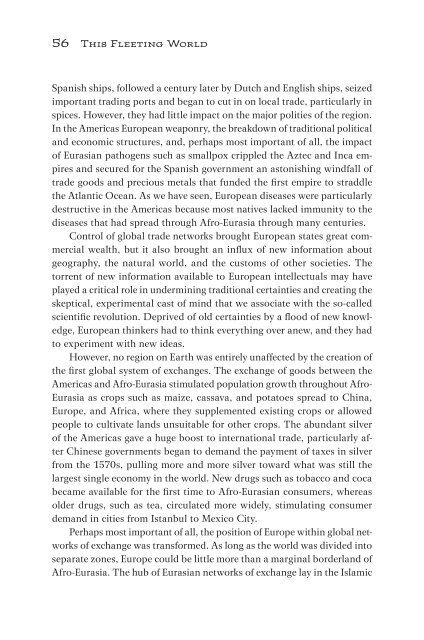This Fleeting World
This Fleeting World
This Fleeting World
Create successful ePaper yourself
Turn your PDF publications into a flip-book with our unique Google optimized e-Paper software.
56 <strong>This</strong> <strong>Fleeting</strong> <strong>World</strong><br />
Spanish ships, followed a century later by Dutch and English ships, seized<br />
important trading ports and began to cut in on local trade, particularly in<br />
spices. However, they had little impact on the major polities of the region.<br />
In the Americas European weaponry, the breakdown of traditional political<br />
and economic structures, and, perhaps most important of all, the impact<br />
of Eurasian pathogens such as smallpox crippled the Aztec and Inca empires<br />
and secured for the Spanish government an astonishing windfall of<br />
trade goods and precious metals that funded the first empire to straddle<br />
the Atlantic Ocean. As we have seen, European diseases were particularly<br />
destructive in the Americas because most natives lacked immunity to the<br />
diseases that had spread through Afro-Eurasia through many centuries.<br />
Control of global trade networks brought European states great commercial<br />
wealth, but it also brought an influx of new information about<br />
geography, the natural world, and the customs of other societies. The<br />
torrent of new information available to European intellectuals may have<br />
played a critical role in undermining traditional certainties and creating the<br />
skeptical, experimental cast of mind that we associate with the so-called<br />
scientific revolution. Deprived of old certainties by a flood of new knowledge,<br />
European thinkers had to think everything over anew, and they had<br />
to experiment with new ideas.<br />
However, no region on Earth was entirely unaffected by the creation of<br />
the first global system of exchanges. The exchange of goods between the<br />
Americas and Afro-Eurasia stimulated population growth throughout Afro-<br />
Eurasia as crops such as maize, cassava, and potatoes spread to China,<br />
Europe, and Africa, where they supplemented existing crops or allowed<br />
people to cultivate lands unsuitable for other crops. The abundant silver<br />
of the Americas gave a huge boost to international trade, particularly after<br />
Chinese governments began to demand the payment of taxes in silver<br />
from the 1570s, pulling more and more silver toward what was still the<br />
largest single economy in the world. New drugs such as tobacco and coca<br />
became available for the first time to Afro-Eurasian consumers, whereas<br />
older drugs, such as tea, circulated more widely, stimulating consumer<br />
demand in cities from Istanbul to Mexico City.<br />
Perhaps most important of all, the position of Europe within global networks<br />
of exchange was transformed. As long as the world was divided into<br />
separate zones, Europe could be little more than a marginal borderland of<br />
Afro-Eurasia. The hub of Eurasian networks of exchange lay in the Islamic


